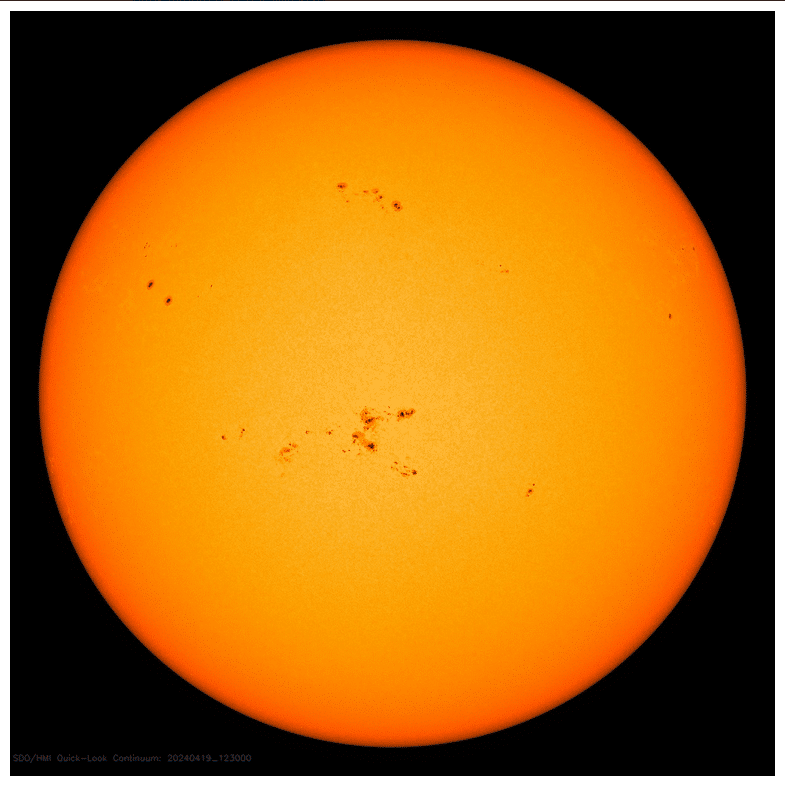Solar activity increased dramatically this reporting week (April
11-17), and thirteen new sunspot groups emerged. One appeared on
April 11, two more on April 13, three more on April 14, another two
on April 15, one more on April 16 and another two on April 17. On
April 18 an additional two sunspot groups emerged, and the daily
sunspot number increased to 247.
The daily sunspot number was 199 on April 17, the highest value
since July 12, 2023 when it was 219. On April 18, when the sunspot
number was 247, it was the highest sunspot number since July 6, 2014
when it was 256. That was back in Solar Cycle 24, so 247 is a new
record for Solar Cycle 25.
Average daily sunspot numbers jumped from 67.9 to 142.7, and average
daily solar flux from 123.2 to 177.4.
Predicted solar flux over the near term is 225 on April 19, 220 on
April 20-21, 215 and 205 on April 22-23, 190 on April 24-25, then
140, 130, 125 and 120 on April 26-29, then 125 on April 30 to May 6,
and 130, 140, 150, 160 and 175 on May 7-11, then 180 on May 12-14,
175 on May 15, 170 on May 16-17, then 167 and 165 on May 18-19, 160
on May 20-21, then 155, 140, 135, 125 and 120 on May 22-26.
Predicted planetary A index is 6, 10, 12 and 8 on April 19-22, 5 on
April 23-27, 8 on April 28-29, 7 on April 30, 10 on May 1-3, 5 on
May 4, 8 on May 5-7, 5 on May 8-11, 10 and 8 on May 12-13, then 5 on
May 14-24, and 8 on May 25-26.
“Weekly Commentary on the Sun, the Magnetosphere, and the Earth’s
Ionosphere – April 18, 2024:
“Over the past weekend, active sunspot regions began to emerge on
the eastern limb as expected. Curiosity about what we would actually
see was heightened because their flare activity during the last
rotation was somewhat higher than usual. Therefore, the CME from a
moderate eruption in the northern hemisphere of the Sun on April 11
with a maximum at 1706 UTC was not a surprise. The arrival of the
particle cloud on April 14 was therefore expected, but it missed the
Earth.
“Another CME was ejected towards Earth on 12 April. Although neither
CME was particularly strong, a G1 class geomagnetic storm was
expected. This occurred on 16 April, so either the particle cloud
moved more slowly or traveled along a longer path toward the Earth.
Either way, the disturbance worsened shortwave propagation on April
16. But the improvement was rapid, starting as early as April 17.
The credit for this goes to the increasing solar radiation coming
from the active regions we can observe on the Sun this week and
next.
“Another weak CME left the Sun on April 15, and the Earth’s impact
was calculated for April 18. However, all predictions of
disturbances at the current stage of the 11-year cycle are
unreliable. They are usually either late (by a day or so) or not at
all. The important thing is the result – due to the relatively high
solar activity and at the same time the small number of geomagnetic
disturbances, the shortwave propagation conditions are mostly above
average. F.K. Janda, OK1HH.”
Check out these videos and an article on flare activity from
EarthSky:
On April 16, Samuel, K5KJ called ARRL headquarters about unusual
propagation he experienced.
He said flare activity caused a radio blackout, and on 40 meters he
could not hear any local or regional signals.
But he noticed foreign broadcast stations from Asia with good
signals.
He said this is just the opposite of what he expected during a
blackout.
Durango Herald article about sunspots and prominences:
NASA on Space Weather:
From Science.Nasa.gov, Solar Moss:
See sunspots with eclipse glasses:
I tried this, but had no luck, as the images were too tiny.
The latest video from Dr. Tamitha Skov, WX6SWW, for April 14:
Send your tips, reports, observations, questions, and comments to
k7ra@arrl.net. When reporting observations, don’t forget to tell us
which mode you were operating.
For more information concerning shortwave radio propagation, see
http://www.arrl.org/propagation and the ARRL Technical Information
Service web page at, http://arrl.org/propagation-of-rf-signals . For
an explanation of numbers used in this bulletin, see
http://arrl.org/the-sun-the-earth-the-ionosphere .
An archive of past propagation bulletins is at
http://arrl.org/w1aw-bulletins-archive-propagation . More good
information and tutorials on propagation are at http://k9la.us/ .
Also, check this QST article about Solar Indices:
Instructions for starting or ending email distribution of ARRL
bulletins are at http://arrl.org/bulletins .
Sunspot numbers for April 11 through 17 2024 were 81, 83, 115, 152,
193, 176, and 199, with a mean of 142.7. 10.7 cm flux was 143.7,
151.5, 161, 178.4, 191.9, 198.7, and 216.5, with a mean of 177.4.
Estimated planetary A indices were 6, 7, 5, 6, 8, 31, and 7, with a
mean of 10. Middle latitude A index was 6, 6, 6, 5, 7, 17, and 8,
with a mean of 7.9.

